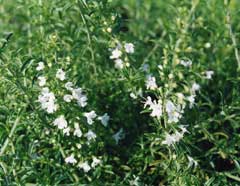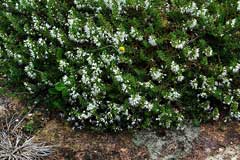 |
|
http://www.fleurs-des-montagnes.net/ |
 |
| http://www.flickr.com/photos/peganum/ |
Translate this page:
Summary
Creeping Savory (S. spicigera) has a low-growing, spreading habit, suitable as a ground cover. It has a stronger flavour than thyme and is used in soups, meats, and vegetables.
Physical Characteristics

 Satureja spicigera is a PERENNIAL growing to 0.1 m (0ft 4in) by 0.6 m (2ft) at a medium rate.
Satureja spicigera is a PERENNIAL growing to 0.1 m (0ft 4in) by 0.6 m (2ft) at a medium rate.
See above for USDA hardiness. It is hardy to UK zone 7. It is in flower from August to September. The species is hermaphrodite (has both male and female organs) and is pollinated by Insects. The plant is self-fertile.
It is noted for attracting wildlife.
Suitable for: light (sandy) and medium (loamy) soils, prefers well-drained soil and can grow in nutritionally poor soil. Suitable pH: mildly acid, neutral and basic (mildly alkaline) soils and can grow in very alkaline soils.
It cannot grow in the shade. It prefers dry or moist soil and can tolerate drought.
UK Hardiness Map
US Hardiness Map
Synonyms
S. repandra. S. reptans. Hort.
Plant Habitats
Cultivated Beds; East Wall. In. South Wall. In. West Wall. In.
Edible Uses
Edible Parts:
Edible Uses: Condiment
Leaves - raw or cooked[238]. A peppery flavour, they are used mainly as a flavouring for cooked dishes, especially beans, but are also used as a garnish for salads etc[183]. They have a stronger flavour than summer savory (S. hortensis)[238]. The leaves can be used fresh or dried[183].
References More on Edible Uses
Medicinal Uses
Plants For A Future can not take any responsibility for any adverse effects from the use of plants. Always seek advice from a professional before using a plant medicinally.
Antirheumatic Antiseptic Aromatic Carminative Digestive Expectorant Stings Stomachic
The whole herb, and especially the flowering shoots, is antiseptic, aromatic, carminative, digestive, expectorant and stomachic[4, 7, 14, 21]. Taken internally, it is said to be a sovereign remedy for colic and a cure for flatulence[4], whilst it is also used to treat nausea, diarrhoea, bronchial congestion, sore throat and menstrual disorders[238]. It should not be prescribed for pregnant women[238]. A sprig of the plant, rubbed onto bee or wasp stings, brings instant relief[4]. The plant is harvested in the summer when in flower and can be used fresh or dried[238]. The essential oil forms an ingredient in lotions for the scalp in cases of incipient baldness[7]. An ointment made from the plant is used externally to relieve arthritic joints[7].
References More on Medicinal Uses
The Bookshop: Edible Plant Books
Our Latest books on Perennial Plants For Food Forests and Permaculture Gardens in paperback or digital formats.

Edible Tropical Plants
Food Forest Plants for Hotter Conditions: 250+ Plants For Tropical Food Forests & Permaculture Gardens.
More

Edible Temperate Plants
Plants for Your Food Forest: 500 Plants for Temperate Food Forests & Permaculture Gardens.
More

More Books
PFAF have eight books available in paperback and digital formats. Browse the shop for more information.
Shop Now
Other Uses
A good companion plant in the garden, growing especially well with onions and beans[201]. The plant is said to inhibit the germination of certain seeds[18]. Secretions from the seeds can prevent the germination of nearby seeds[201]. Members of this genus are rarely if ever troubled by browsing deer[233]. Dynamic accumulator
Special Uses
Attracts Wildlife Dynamic accumulator
References More on Other Uses
Cultivation details
An easily grown plant when given suitable conditions, it prefers a well-drained poor stony soil[4, 14, 27, 52] and succeeds in a hot dry sunny position[200]. It prefers an alkaline soil[200], though is not too fussy. It is intolerant of soils that remain damp and dislikes shade[200]. Plants are hardy to at least -10°c[200] when grown in suitable conditions, but are less hardy in rich soils or damp conditions[K]. A good bee plant[200].
References Carbon Farming Information and Carbon Sequestration Information
Temperature Converter
Type a value in the Celsius field to convert the value to Fahrenheit:
Fahrenheit:
The PFAF Bookshop
Plants For A Future have a number of books available in paperback and digital form. Book titles include Edible Plants, Edible Perennials, Edible Trees,Edible Shrubs, Woodland Gardening, and Temperate Food Forest Plants. Our new book is Food Forest Plants For Hotter Conditions (Tropical and Sub-Tropical).
Shop Now
Plant Propagation
Seed - surface sow in April in a greenhouse. Do not allow the compost to dry out. Germination can be slow and erratic[1] but usually takes place within a month[K]. Prick out the seedlings into individual pots as soon as they are large enough to handle. It is usually possible to plant out into their permanent positions during the summer, but if the plants have not grown sufficiently, or if you live in an area of cold winters, it might be best to grow them on in a cold frame for their first winter and plant them out in late spring or early summer of the following year[K]. Cuttings of half-ripe wood, 5 - 8cm taken at a node, July/August in a frame. Pot up in autumn and overwinter in a frame, planting out in late spring or early summer of the following year. A high percentage usually succeed[78]. Cuttings of young wood, preferably with a heel, April/May in a frame[1, 37]. Plant out in the summer if the plants grow well, otherwise overwinter them in a cold frame and plant out in late spring or early summer of the following year[K]. Division in early spring as growth commences[78, 200]. This works best if soil has been mounded up into the bottom 20cm of the plant early in the previous summer[78]. Pot up the divisions and grow them on in a cold frame until they are established. Plant them out in the summer.
Other Names
If available other names are mentioned here
Native Range
TEMPERATE ASIA: Iran, Armenia, Azerbaijan, Georgia (Abkhazia, Ajaria, Guria, Samegrelo-Zemo Svaneti), Russian Federation (Checheno-Ingushetia, Dagestan, Kabardino-Balkaria, North Ossetia)
Weed Potential
Right plant wrong place. We are currently updating this section.
Please note that a plant may be invasive in one area but may not in your area so it's worth checking.
Conservation Status
IUCN Red List of Threatened Plants Status :

Growth: S = slow M = medium F = fast. Soil: L = light (sandy) M = medium H = heavy (clay). pH: A = acid N = neutral B = basic (alkaline). Shade: F = full shade S = semi-shade N = no shade. Moisture: D = dry M = Moist We = wet Wa = water.
Now available:
Food Forest Plants for Mediterranean Conditions
350+ Perennial Plants For Mediterranean and Drier Food Forests and Permaculture Gardens.
[Paperback and eBook]
This is the third in Plants For A Future's series of plant guides for food forests tailored to
specific climate zones. Following volumes on temperate and tropical ecosystems, this book focuses
on species suited to Mediterranean conditions—regions with hot, dry summers and cool, wet winters,
often facing the added challenge of climate change.
Read More
Expert comment
Author
(K.Koch.)Boiss.
Botanical References
200
Links / References
For a list of references used on this page please go here
Readers comment
| Add a comment |
|
If you have important information about this plant that may help other users please add a comment or link below. Only comments or links that are felt to be directly relevant to a plant will be included. If you think a comment/link or information contained on this page is inaccurate or misleading we would welcome your feedback at [email protected]. If you have questions about a plant please use the Forum on this website as we do not have the resources to answer questions ourselves.
* Please note: the comments by website users are not necessarily those held by PFAF and may give misleading or inaccurate information.
To leave a comment please Register or login here All comments need to be approved so will not appear immediately.
|
Subject : Satureja spicigera
|
|
|
|